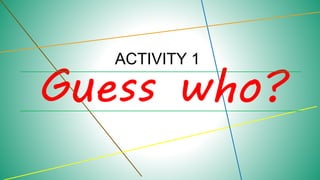
1. cell theory
- 2. CELL Why do we need to discuss this? theory
- 3. ROBERT HOOKE(1635- 1703) In 1665, an English scientist, Robert Hooke examined a thin size of cork under the microscope. He observed that the piece of cork was composed of many tiny compartments that resembled little rooms with surrounding walls. Hooke named these compartments cells. The Hooke observed were not living. He concentrated his study only on the structure, particularly the cell wall, and did not pursue his investigation of the cell content.
- 4. ROBERT HOOKE(1635- 1703) FIGURE 1. The tiny compartments that resembled little rooms with surrounding walls that was observed by Hooke
- 5. Anton van Leeuwenhoek (1632- 1723) In 1674, the Dutch inventor Anton van Leeuwenhoek observed red blood cells, sperm cells, and a multitude of single- celled organisms in pond water. He discovered free cells and observed the nucleus within some red blood cells. It was he who also discovered bacteria, free-living and parasitic protists, and many other microscopic organisms. His researches opened up an entire world of microscopic life to other scientists.
- 6. ROBERT brown(1773- 1858) Another scientist, a Scottish botanist named Robert Brown, discovered the nucleus in 1831. He also theorized that this structure is a fundamental and constant component of the cell. Aside from giving the cell nucleus its name. Brown also honoured for his discovery of cell phenomenon called Brownian Movement, the random movement of minute particles of matter suspended in a fluid. He came about this discovery in 1827, when he observed the movement of plant spores floating in water.
- 7. Felix dujardin(1802- 1860) In 1835, a French biologist, Felix Dujardin found out that living cells contain an internal substance. Not knowingly exactly what this substance was, Dujardin gave it the name sarcode. sarcode
- 8. Jan Evangelista Purkenji (1787- 1869) It was a Bohemian physiologist, Jan Evangelista Purkenji who made a thorough investigation of this internal material. He gave it the name protoplasm, the colloidal substance in the cell. protoplasm
- 10. Matthias schleiden(1804- 1882) In 1838, Matthias Schleiden, a German botanist stated that all plants are composed of cells.
- 11. Theodor schwann(1810- 1882) After Schleiden, in 1839, German zoologist Theodor Schwann concluded that all animals are composed of cells.
- 12. Scleiden and schwann Jointly, Schleiden and Schwann came out with the theory that all living things are composed of cells.
- 13. Rudolph virchow (1821- 1902) Twenty years later, in 1858, a German biologist, Rudolph Virchow theorized that all living cells come from pre-existing living cells. His conclusion arose from observing dividing cells during his work. CELL DIVISION
- 14. Cell theory These observations became a major components of the cell theory. The cell theory states that: (1) all living things are composed of one or more cells and cell products (2) all living cells come from other living cells by the process of cell division (3) cells are basic units of structure and function in organisms
- 15. Questions?
- 17. Review!!!!!!
- 18. Assessment TEST I. IDENTIFICATION Instruction: Identify the person who made the significant discovery of the following statement. Refer your answer from the ‘Name Bank’. WRONG SPELLING IS CONSIDERED WRONG. Brown Hooke Leeuwenhoek Dujardin Purkenji Schleiden Schwann Virchow 1. He made a thorough investigation of the internal material and named it ‘protoplasm’. 2. He concluded that all animals are composed of cells. 3. He named the tiny compartments from the cork as cells. 4. He theorized that the nucleus is a fundamental and constant component of the cell. 5. He discovered bacteria, free-living and parasitic protists, and many other microscopic organisms. 6. He found out that living cells contain internal substance and he named it sarcode. 7. He was honoured for his discovery of cell phenomenon called Brownian Movement. 8. He stated that all plants are composed of cells. 9. The scientist who discovered that cells are came from existing cells by division process. 10. They came out with the theory that all living things are composed of cells.
- 19. Assessment TEST I. IDENTIFICATION Instruction: Identify the person who made the significant discovery of the following statement. Refer your answer from the ‘Name Bank’. WRONG SPELLING IS CONSIDERED WRONG. Brown Hooke Leeuwenhoek Dujardin Purkenji Schleiden Schwann Virchow 1. He made a thorough investigation of the internal material and named it ‘protoplasm’. 2. He concluded that all animals are composed of cells. 3. He named the tiny compartments from the cork as cells. 4. He theorized that the nucleus is a fundamental and constant component of the cell. 5. He discovered bacteria, free-living and parasitic protists, and many other microscopic organisms. 6. He found out that living cells contain internal substance and he named it sarcode. 7. He was honoured for his discovery of cell phenomenon called Brownian Movement. 8. He stated that all plants are composed of cells. 9. The scientist who discovered that cells are came from existing cells by division process. 10. They came out with the theory that all living things are composed of cells. PURKENJI SCHWANN HOOKE BROWN LEEUWENHOEK DUJARDIN BROWN SCHLEIDEN VIRCHOW SCHLEIDEN and SCHWANN
- 20. Thank you!